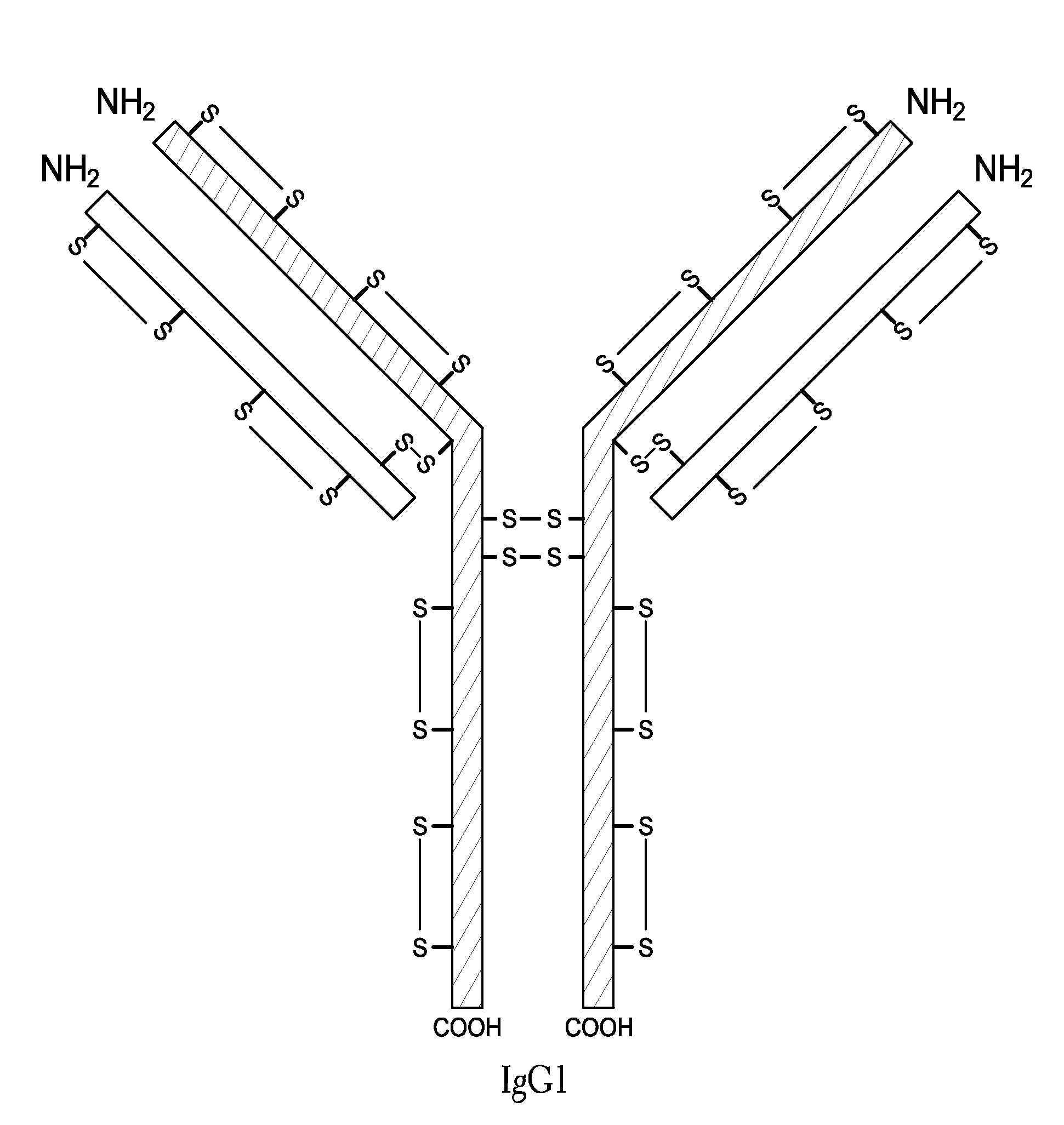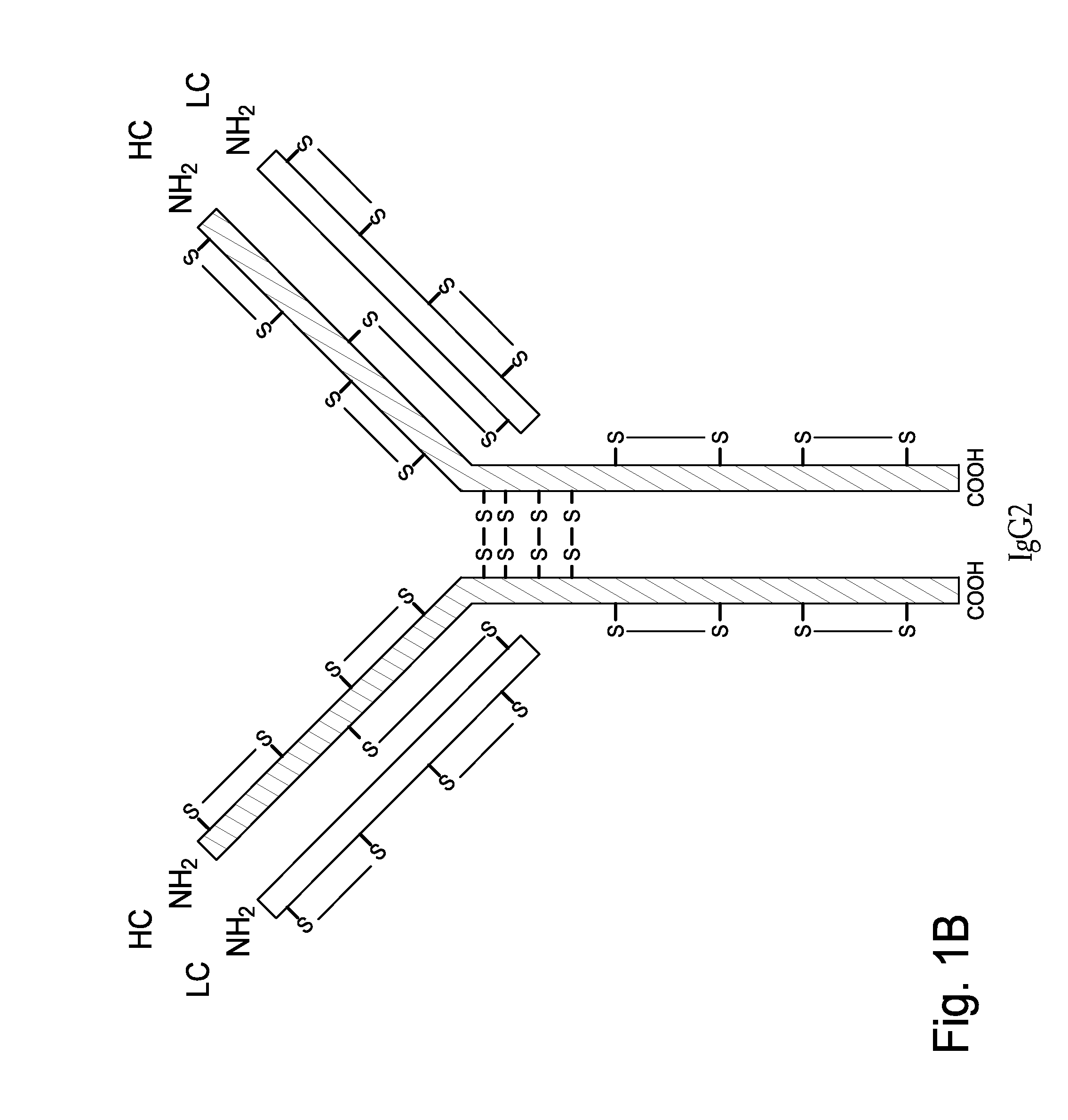Homogeneous Antibody Populations
a technology of homogeneous antibody populations and antibody fusion, which is applied in the direction of fused cells, immunological disorders, drug compositions, etc., can solve the problems of limited structural information documenting the assignment of disulfide bonds, and achieve efficient and economic production, improve storage stability, and improve the effect of pharmaceutical properties
- Summary
- Abstract
- Description
- Claims
- Application Information
AI Technical Summary
Benefits of technology
Problems solved by technology
Method used
Image
Examples
example 1
Modeling of IgG2 CH1 and Hinge Proximity
[0170]A three-dimensional model of an IgG2 antibody was created to study the location of disulfide bonds in wild-type antibody molecules. This model illustrated the close spatial proximity of the IgG2 CH1Cys residue (Cys-131) with the hinge residues Cys-219 and Cys-220 and the inter-chain disulfide bonding light chain Cys residue (Cys-214). The three-dimensional model of an IgG2 antibody was constructed as follows:
[0171]The CH1 amino acid sequence of human IgG2 monoclonal antibody anti-EGFr (as described in U.S. Pat. No. 6,235,883, incorporated herein by reference in its entirety) was modeled against the known CH1 structure of an IgG4 antibody (pdb accession code 1ad9; Banfield, M. J. and Brady, R. L. (1997) Proteins 29: 161-171). The amino acid sequence identity between the CH1 sequence of anti-EGFr and the template was 96% and the positions and identity of all Cys residues were absolutely conserved. The resulting IgG2 CH1 model was superpose...
example 2
Mutation of Monoclonal Antibody Anti-RANKL
[0173]Anti-RANKL is a human monoclonal IgG2 antibody directed against Receptor Activator of Nuclear Factor Kappa B Ligand (RANK-L). Anti-RANKL is composed of two HCs and two LCs that are linked through intermolecular disulfide bonds. Each HC is encoded to yield 448 amino acids and each LC, which belongs to the kappa subtype, consists of 215 amino acids with a Cys residue at the C-terminus. As discussed above, human IgG2 antibodies in solution exhibit heterogeneity among the inter-chain disulfide bridges.
[0174]In order to simplify the disulfide connectivity among the CL, CH1 domains and the hinge, a mutant form of anti-RANKL was produced. In this mutant form, the third Cys residue in both of the heavy chains, Cys131, was replaced with a serine residue (FIG. 7) to make as C131S mutant. Briefly, DNA encoding wild-type anti-RANKL was obtained as described in WO 03 / 002713 (incorporated herein by reference in its entirety). The anti-RANKL C131S mu...
example 3
Structural Characterization of Anti-RANKL Mutant Antibodies
[0177]The C131S mutant form of anti-RANKL was characterized side-by-side with the wild-type anti-RANKL using a variety of analytical techniques as described below (SE-HPLC, CEX-HPLC, CE-SDS, SDS-PAGE and RP-HPLC. The disulfide linkages of the mutant form were also characterized by a non-reduced peptide mapping technique.
SE-HPLC of Anti-RANKL Antibody
[0178]SE-HPLC is a reliable technique for determining molecular size or hydrodynamic volume of proteins under non-denaturing conditions. The SE-HPLC analysis of anti-RANKL was performed to determine its purity. The method utilized two Toso Hass TSK-GEL G3000SWXL columns in series and 20 mM sodium phosphate, 250 mM NaCl, pH 7.0 as the mobile phase in order to distinguish monomeric anti-RANKL from aggregates and lower molecular weight clipped forms. The elution profile was monitored at 215 nm rather than 280 nm due to the low concentration (3.8 mg / mL) of the anti-RANKL Cys131Ser mu...
PUM
| Property | Measurement | Unit |
|---|---|---|
| Stability | aaaaa | aaaaa |
Abstract
Description
Claims
Application Information
 Login to View More
Login to View More - R&D
- Intellectual Property
- Life Sciences
- Materials
- Tech Scout
- Unparalleled Data Quality
- Higher Quality Content
- 60% Fewer Hallucinations
Browse by: Latest US Patents, China's latest patents, Technical Efficacy Thesaurus, Application Domain, Technology Topic, Popular Technical Reports.
© 2025 PatSnap. All rights reserved.Legal|Privacy policy|Modern Slavery Act Transparency Statement|Sitemap|About US| Contact US: help@patsnap.com



